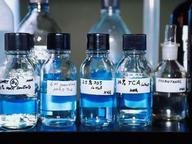Quiz Answer Key and Fun Facts
1. Which of the following has the weakest conjugate base?
2. Which of the following mixtures forms a buffer solution, given that the volume and concentration of both the constituents is equal?
3. Which of the following is UNTRUE about acid-base indicators, according to Ostwald's theory?
4. Take the equilibrium reaction X + Y ⇌ 2Z
The concentrations of X , Y and Z are 1, 1 and 2 moles per liter respectively. The equilibrium constant at the temperature is 5. In which way does the net reaction proceed?
5. The value of pKa of an acid is 6.0, and its concentration is 0.01 M. What is going to be the percentage of disassociation of the acid?
(Assume that the degree of disassociation is so low that the change in the acid's concentration is negligible).
6. Which of the following is going to have the least resultant pH?
7. Lewis acids don't need to contain hydrogen in order to be classified as acids.
8. I am titrating a sample solution of a strong base with equal concentrations and amounts of a strong acid and a weak acid. With the help of a pH probe, I am obtaining a titration curve with y-axis showing me the pH and the x-axis, the amount of respective acid added.
How can I distinguish which graph belongs to the weak acid?
9. Which of the following salts cannot undergo hydrolysis?
10. Which of the following statements is ALWAYS true?
Source: Author
pokho
This quiz was reviewed by FunTrivia editor
rossian before going online.
Any errors found in FunTrivia content are routinely corrected through our feedback system.

